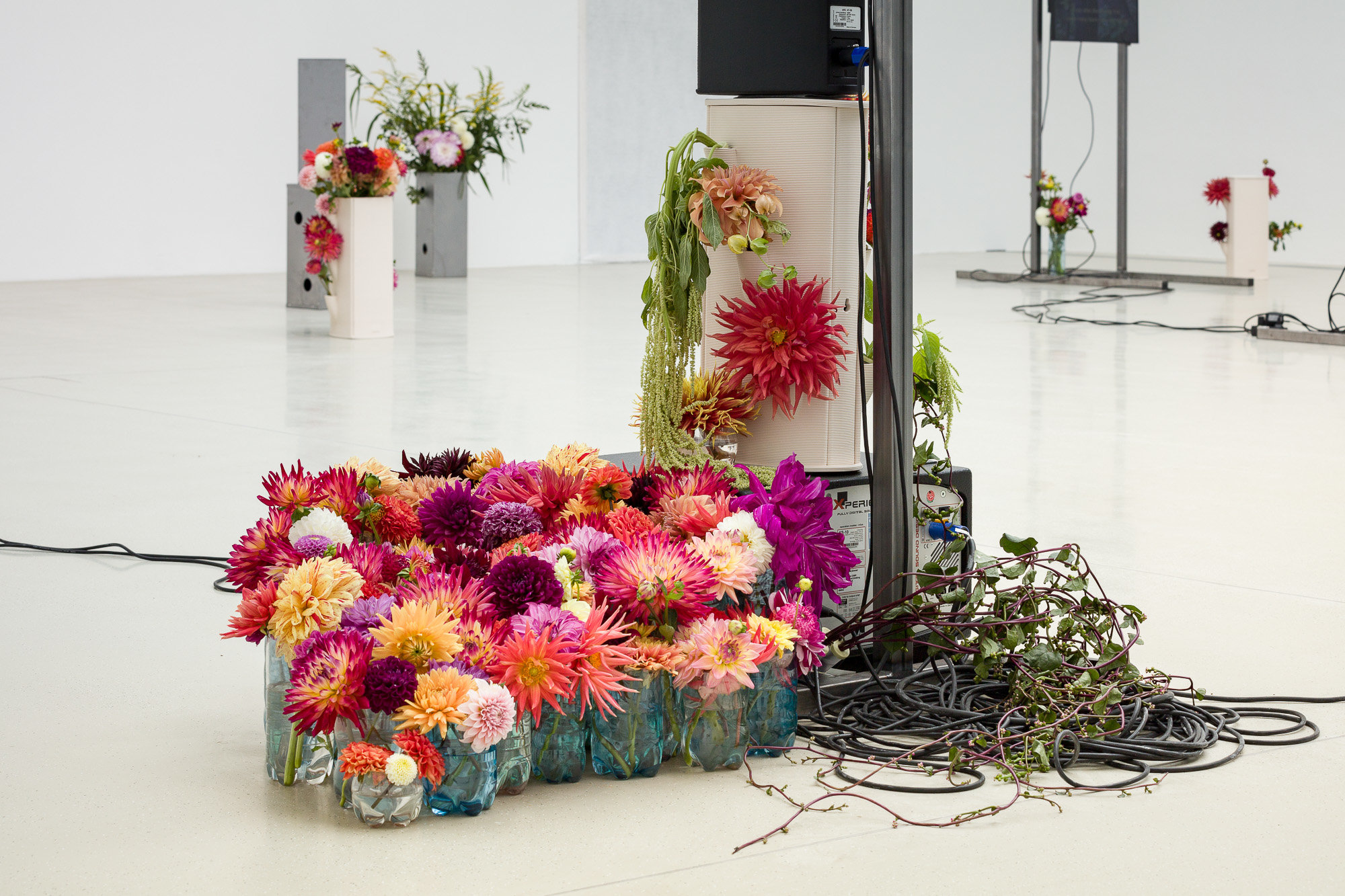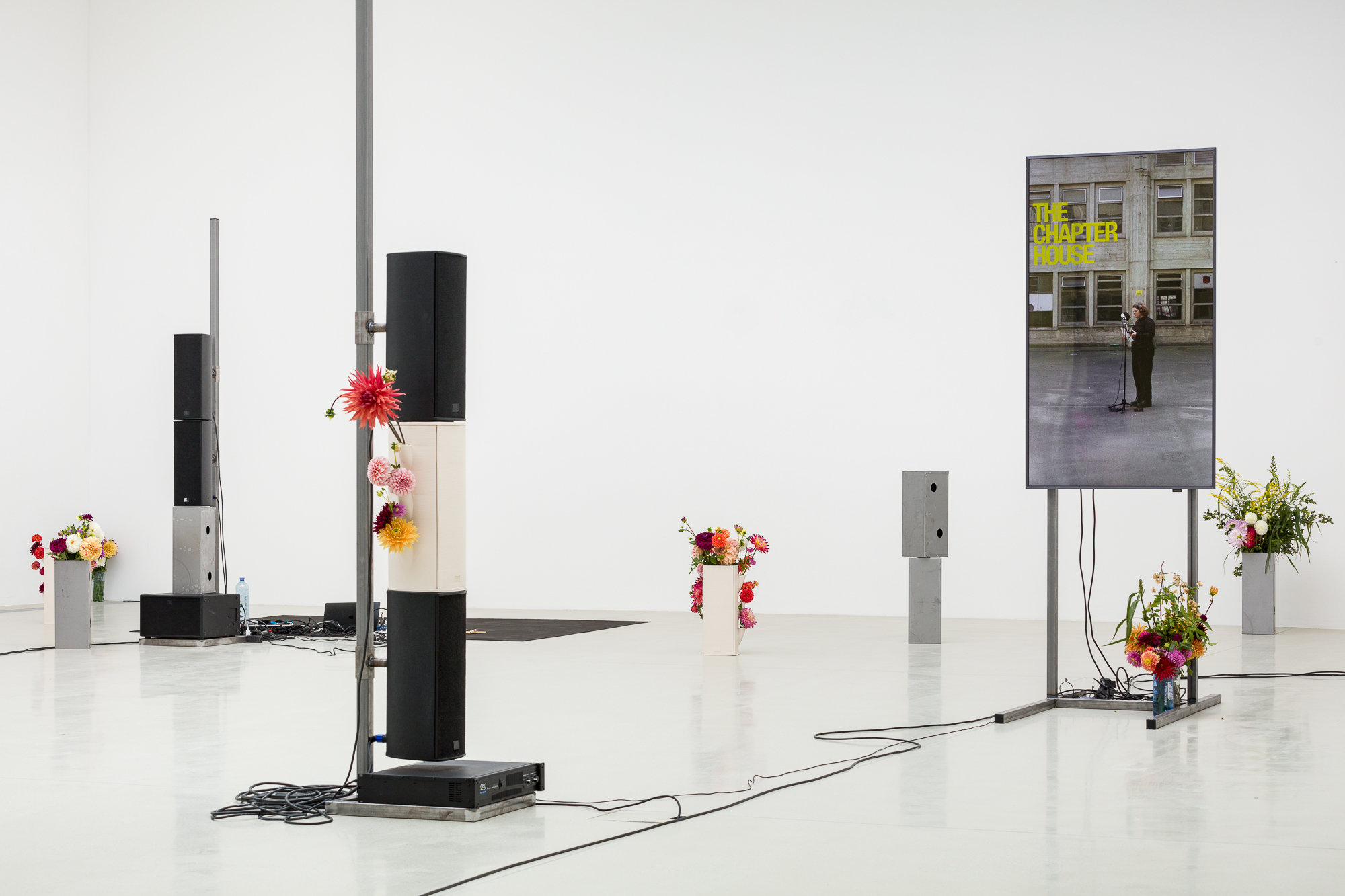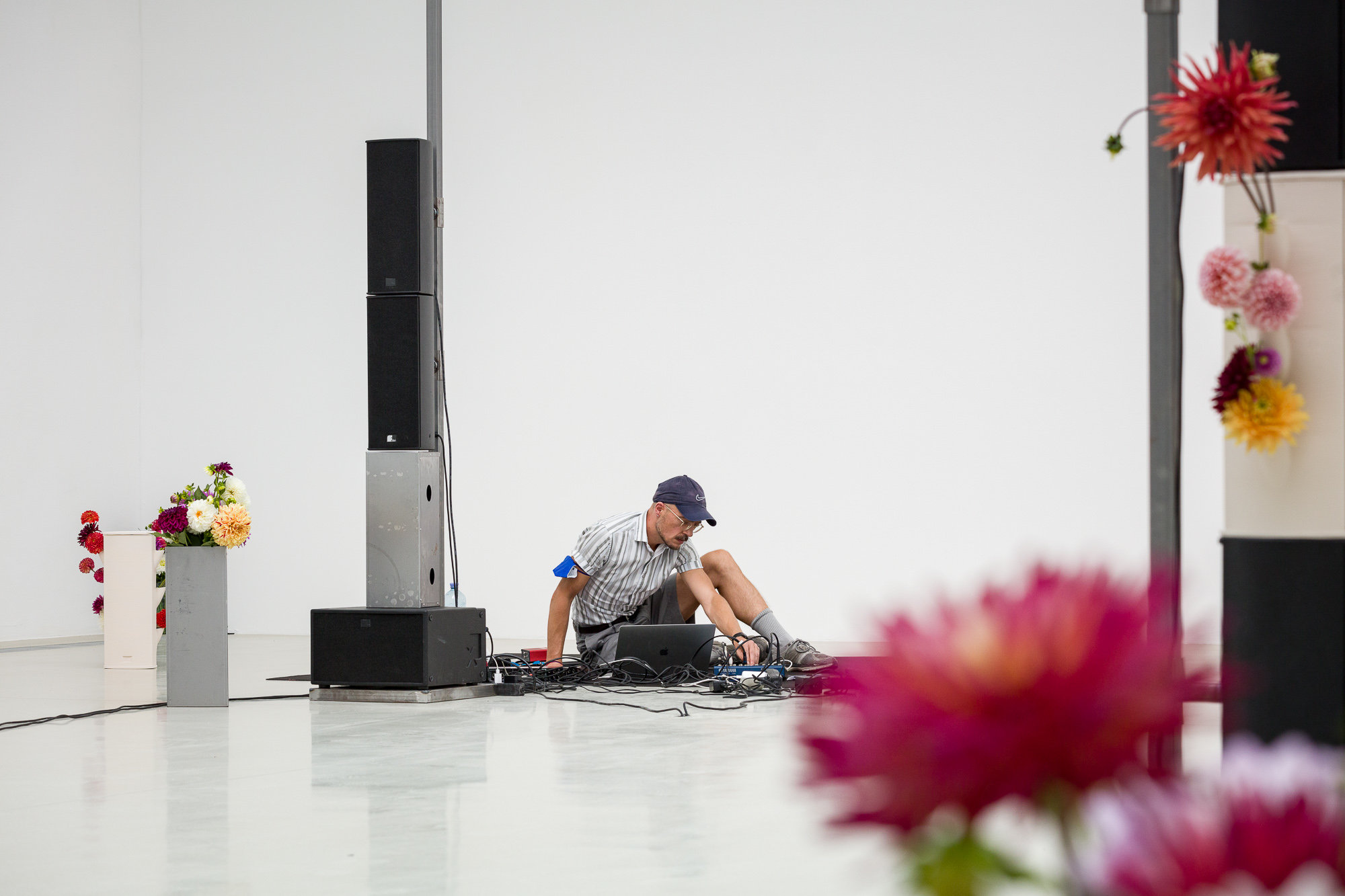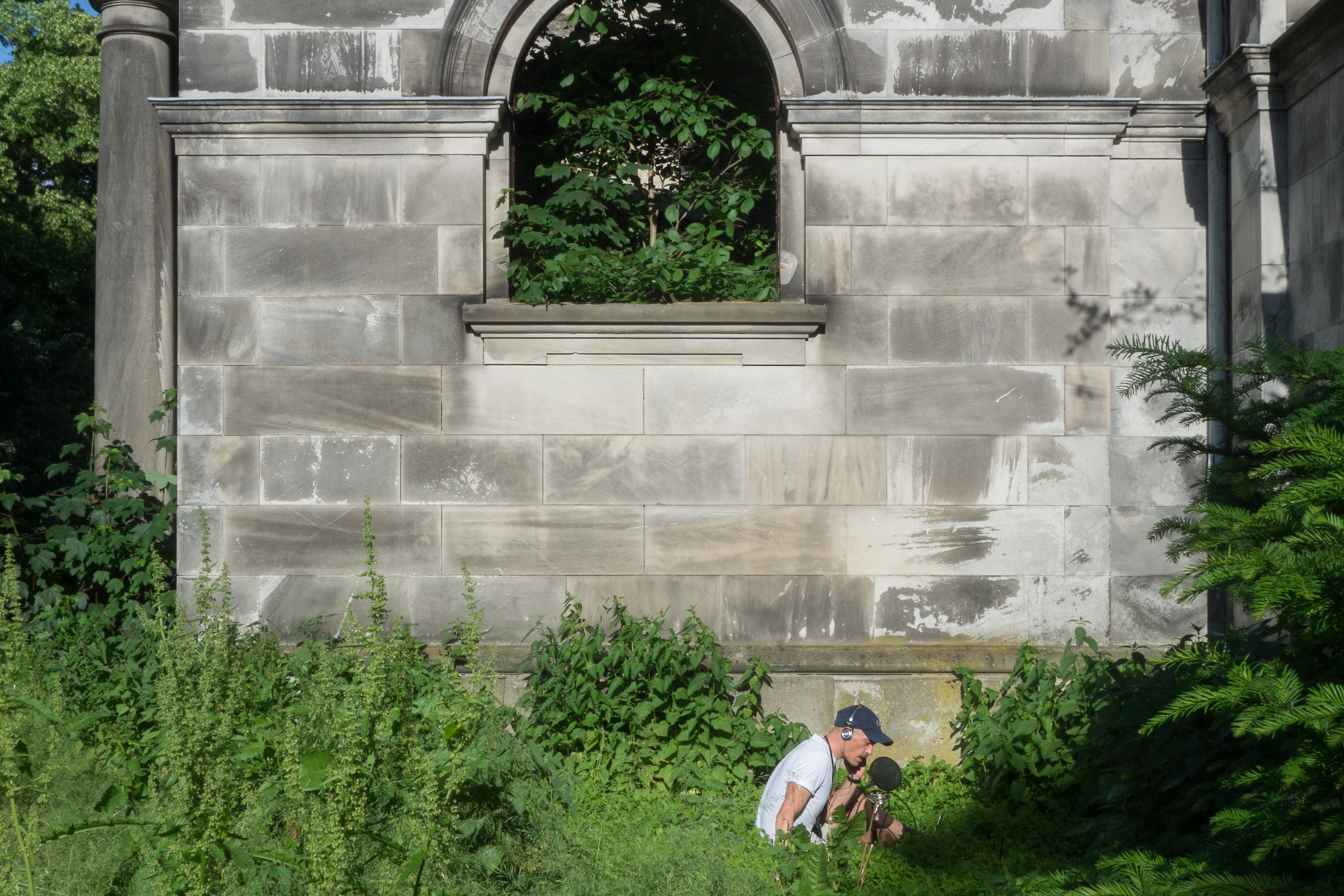Give Rise To Armin Lorenz GeroldVerstärkung (Amplification)20.–21.8.2021
Performance
With contributions by: Alice Cannava, Alejandro Alonso Díaz, Jennifer Hope Davy, Enver Hadzijaj, Cornelia Herfurtner, Sinaida Michalskaja, Miriam Stoney, Bruno Zhu
Floral installation: Barbara Urbanic
How can sound be made visible? This question is repeatedly asked in the practice of the artist Armin Lorenz Gerold (*1981 Graz, lives in Berlin). For the performance and installation Verstärkung (Amplification) (2021), a new work commissioned by HALLE FÜR KUNST Steiermark, Gerold created an audiovisual system of sculptures and flat monitors. His multi-disciplinary practice, which can be fundamentally defined as an investigation of photography and sound, transforms classical exhibition contexts into acoustic landscapes. Gerold, whose formats also always establish points of reference to radio and streaming, allows his audience to immerse themselves into a meditative flow of language and sounds.
Views
Give Rise To Armin Lorenz Gerold, 2021
Verstärkung (Amplification)
Camera & Sound: kunst-dokumentation.com; Editor: Kevin Ferdinandus

Armin Lorenz Gerold, Verstärkung (Amplification), 2021
Installation view, video und sound, ceramics, steel, flowers
Photo: kunst-dokumentation.com

Armin Lorenz Gerold, Verstärkung (Amplification), 2021
Installation view, video und sound, ceramics, steel, flowers
Photo: kunst-dokumentation.com

Armin Lorenz Gerold, Verstärkung (Amplification), 2021
Performance
Photo: kunst-dokumentation.com

Armin Lorenz Gerold, Verstärkung (Amplification), 2021
Performance
Photo: kunst-dokumentation.com

Armin Lorenz Gerold, Verstärkung (Amplification), 2021
Installation view, video und sound, ceramics, steel, flowers
Photo: kunst-dokumentation.com

Armin Lorenz Gerold, Untitled, 2021
Production Still
Photo: Armin Lorenz Gerold
Text
After a year of physical isolation due to the Covid-19 pandemic and global political unrest, Verstärkung (Amplification) (2021) addresses the ways in which communication is changing within ever more complex digital systems. The title of the work thereby indicates one of the starting points of Gerold’s proposition to use elements from sound and music production as the symbolic equivalents of political phenomena. Verstärkung (Amplification) (2021) thus refers on the one hand to the electronic process of amplifying a signal, and on the other the word amplification stands from the artist’s perspective for the phenomenon of solidarity advocated by different political groups and their public proclamations of this. In the specific context of this work, amplification means telling and sharing experiences of encouragement and support.
Gerold places sculptures around the gallery, consisting of real loudspeakers and replicas made of ceramics. The latter, made using 3D printing, have protuberances looking like small goblets on their sides. In these there are flowers, transforming the loudspeakers — their original form — unmistakably into vases. A number of flat screen monitors therein mounted on metal rods, due to their large size, have the appearance of sculptures. The screens show videos in which Gerold and other artists are reading various texts. With the inclusion of these collaborators, Gerold “amplifies” various voices that speak from and on behalf of different political and social contexts.
Recorded soundscapes are emitted from the objects — or sculptures — placed in the exhibition gallery. This term encompasses the sounds of a human environment, and includes sounds from nature, music, and language, and also noises that are caused by various activities such as industrial production and work. Gerold is currently collecting a personal archive of soundscapes, and has most recently been interested in the noises of marching and demonstrating bodies. By means of well-measured prerecorded sound sources, Gerold produces live sets that intervene more disruptively into his installations. This reflects the artist’s interest in using sound to provide an experience of the principles of manipulative communication technologies, such as those used in the social media.
Among other examples, sounds of water are combined, each recorded on the two banks of the Mur River that runs through the city of Graz. By using these sounds, the artist refers directly to the city and its geographical and also demographic structures. The two recordings of the sound of water are not clearly distinguishable, and thus they leave it open whether it is possible to really divide the city into two different parts.
Here sound is associated with politics by means of a system of values that recurs in another aspect of this artwork: the ceramics that look like both loudspeakers and vases are used as so-called tulipieres, pottery vases with not one but several smaller openings for inserting flowers that can each be individually presented. Tulipieres were invented in The Netherlands during the second half of the sixteenth century, at the time of what became known as “tulip mania,” when tulips were the subject of speculation and this led to one of the first major financial crises in Europe.
Inspiration for the artist provides amongst others the media and cultural theorist McKenzie Warck in A Hacker Manifesto (2004), criticizing the increasing commodification of information in the age of digitalization and globalization. According to Warck, the emergence of the internet has fundamentally changed the essence and idea of our general understanding of property. Ownership is no longer connected only to the material world, but in the age of file sharing also to intellectual property.
In Verstärkung (Amplification) (2021) all of these parallel levels of meaning come together in sound, language, and images within the poetic practice of the artist. This work thereby becomes a sounding board that offers not just a depiction, but a real and tangible experience of the local and global political and economic mechanisms that influence our bodies and minds and the ways in which we communicate.
Curated by Cathrin Mayer
Artists
Participating artists
Armin Lorenz Gerold
is an artist and composer.
His work has been presented at KW Institute for Contemporary Art in Berlin, at LambdaLambdaLambda, Prishtina; at fluent, Santander; mint, Stockholm; and the Gothenburg Biennial of Contemporary Art (in collaboration with Doireann O’ Malley). In spring 2021, a new radio play installation will be accompanied by an artist’s book published as part of the Ruisdael Fellowship the artist received.
Gerold releases pop music under his virtual alter ego wirefoxterrier, which is featured on the soundtrack of the LGBT teen drama SKAM Italia. The debut EP Radio Pristina was released in 2020.
Reviews
- berlinartlink, "Tuning In: An Interview with Armin Lorenz Gerold", Alison Hugill Online, 22.9.2021
- Kronen Zeitung, " Graz: A.L. Gerold in der Halle für Kunst. Klang des Protests", Ch. Hartner Print, 21.8.2021, PDF (828 KB)
- Steiermark Magazin, "Im digitalen Garten spielen", Helmut Bast Print, 31.8.2021, PDF (3 MB)
- Contemporary Art Library, Los Angeles Online
Press
Downloads & Dates
- flyer_armin_lorenz_gerold.pdf PDF (518 KB)
- presse_armin_lorenz_gerold.pdf PDF (85 KB)
- press_armin_lorenz_gerold.pdf PDF (88 KB)